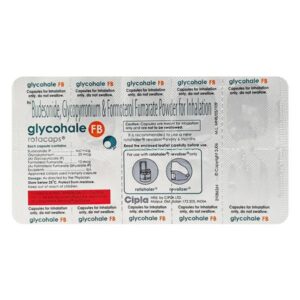BUDESONIDE + FORMOTEROL + GLYCOPYRROLATE
Budesonide: Budesonide is a medication that belongs to the class of drugs known as corticosteroids. It is mainly used to treat various conditions that involve inflammation in the body, such as Crohn’s disease, ulcerative colitis, asthma, and allergic rhinitis.
The exact mechanism of action of budesonide is not fully understood, but it is believed to work by reducing the production and release of substances in the body that cause inflammation. It has potent anti-inflammatory properties and helps to alleviate the symptoms associated with the aforementioned conditions.
The dose of budesonide varies depending on the specific condition being treated. It is available in various forms, including oral capsules, inhalers, and nasal sprays. The dosage and duration of treatment are typically determined by the prescribing healthcare professional based on the severity of the condition and the individual patient’s response.
As with any medication, budesonide may cause some side effects. Common side effects include headache, nausea, abdominal pain, indigestion, dizziness, and nasal congestion. Long-term use or high doses of budesonide may pose a risk of more serious side effects such as adrenal suppression (which can affect the body’s ability to produce natural steroids), increased susceptibility to infections, osteoporosis (bone loss), and mood changes. It is important to discuss any concerns or potential side effects with a healthcare professional before starting budesonide.
Formoterol: Formoterol is a long-acting bronchodilator that belongs to the class of medications known as beta-2 adrenergic agonists. It is primarily used for the management of bronchospasm in patients with reversible obstructive airway diseases, such as asthma and chronic obstructive pulmonary disease (COPD).
The primary mechanism of action of Formoterol is to stimulate the beta-2 adrenergic receptors in the smooth muscles of the airways, thereby causing relaxation and dilation of the bronchial tubes. This leads to improved airflow and relief of bronchospasm.
Formoterol is available in various formulations, including as an inhalation powder and as a solution for inhalation. It is often used in combination with an inhaled corticosteroid to provide both long-term control and quick relief of symptoms in patients with asthma. In patients with COPD, Formoterol helps to relieve symptoms such as shortness of breath and wheezing.
The recommended dosage of Formoterol may vary depending on the specific formulation. For the inhalation powder, the usual dose is 1 inhalation twice daily, with at least 12 hours between doses. However, it is important to follow the instructions provided by the healthcare provider or found on the package insert for the specific product.
Like any medication, Formoterol can cause side effects. The most common side effects include headache, shaking/tremors, nervousness, throat irritation, and muscle cramps. Some patients may also experience an increase in heart rate or blood pressure. Very rarely, Formoterol may cause paradoxical bronchospasm, which is characterized by a worsening of breathing difficulties and wheezing.
It is important to note that Formoterol should not be used as a rescue medication for acute bronchospasm. Patients should always have a short-acting bronchodilator like albuterol on hand for immediate relief of symptoms. If symptoms worsen or do not improve with Formoterol, patients should seek medical attention promptly.
Glycopyrrolate: Glycopyrrolate is a medication that is primarily used to reduce excessive saliva or drooling and to control respiratory secretions during surgeries or other medical procedures. It may also be prescribed for the treatment of certain gastrointestinal disorders such as peptic ulcers or irritable bowel syndrome.
The drug works by blocking the action of acetylcholine, a neurotransmitter that is responsible for controlling the secretion of saliva and other bodily fluids. By inhibiting the effects of acetylcholine, glycopyrrolate reduces the production of saliva and respiratory secretions.
Glycopyrrolate is available in tablet, injection, and oral solution forms. The dose and frequency of administration can vary depending on the individual’s age, condition being treated, and other factors. It is important to follow the prescribed dosage instructions provided by a healthcare professional.
Like any medication, glycopyrrolate can cause side effects. Common side effects may include dry mouth, constipation, urinary retention, blurred vision, dizziness, drowsiness, or confusion. These effects are usually mild and temporary. However, if any severe side effects are experienced, such as difficulty breathing, rapid heartbeat, or allergic reactions, immediate medical attention should be sought.
It is important to inform the prescribing healthcare professional about any existing medical conditions, allergies, or medications being taken before starting glycopyrrolate to ensure its safe and effective use. Ultimately, the benefits and risks of using this medication should be discussed with a healthcare professional before beginning treatment.

